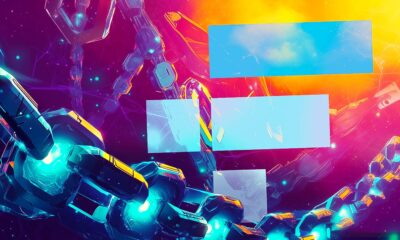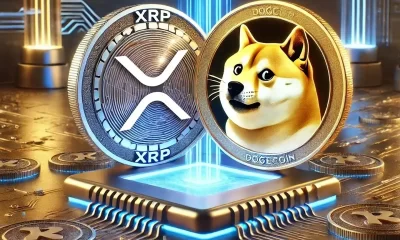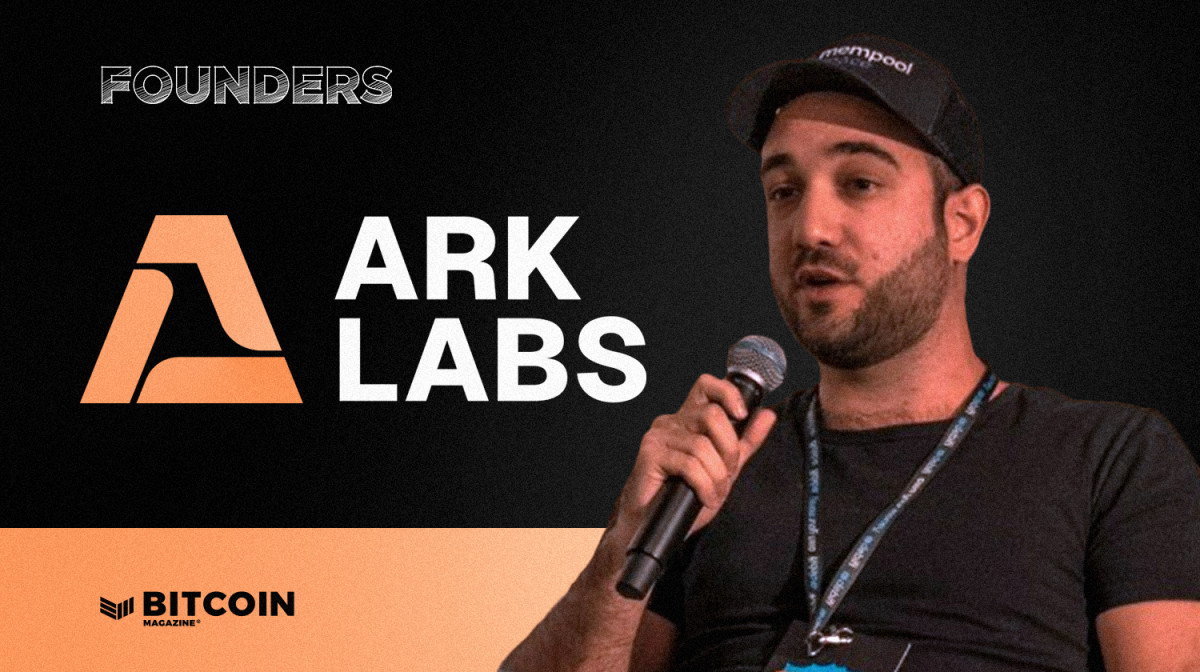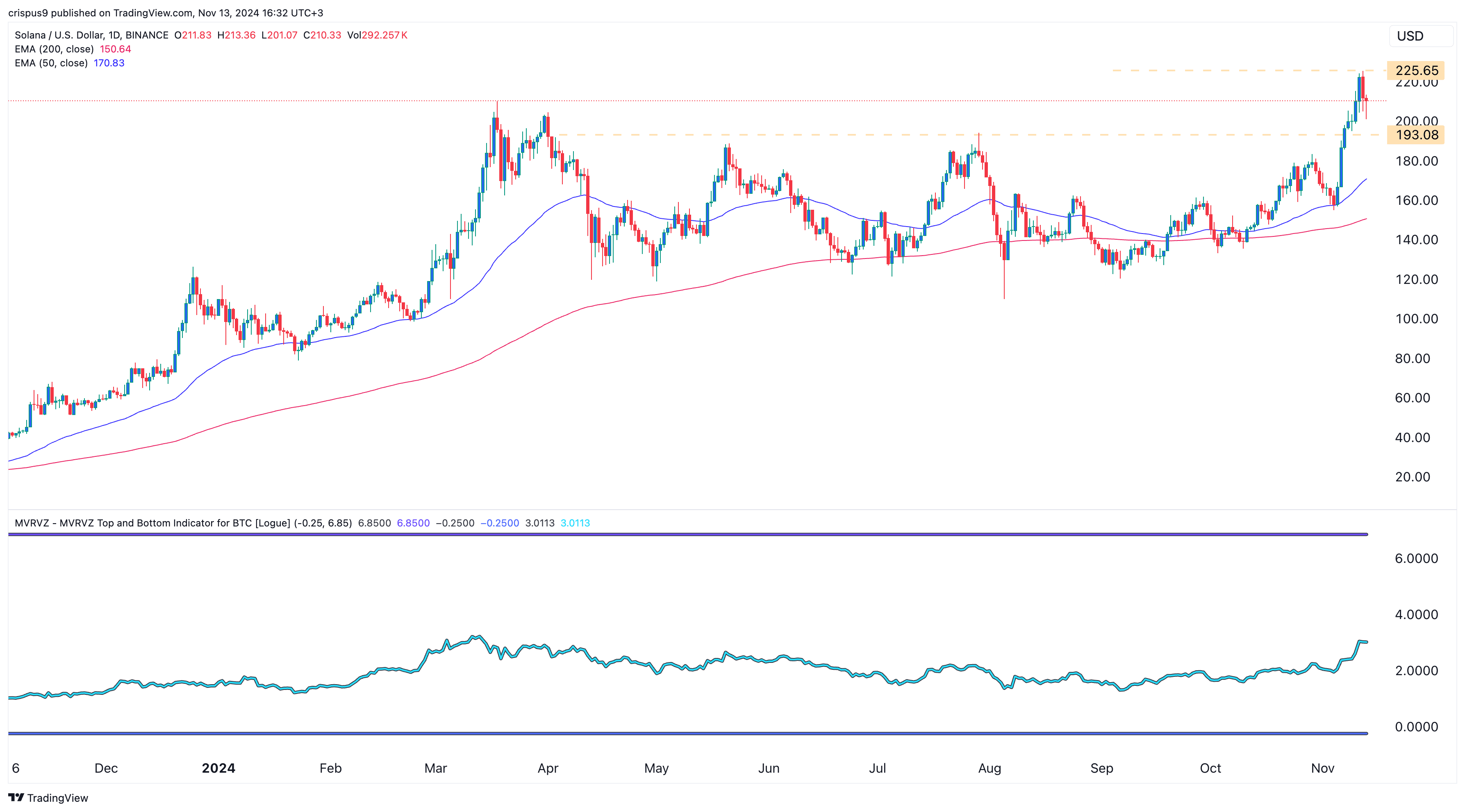Layer 2
Starknet unveils first voting proposal to bring staking to STRK holders
Published
3 months agoon
By
admin

Starknet announces its first mainnet vote for STRK holders, which is set to introduce staking with a potential launch in October.
Starknet (STRK), the layer-2 network developed by StarkWare, is set to introduce staking to its ecosystem, beginning through its first-ever mainnet vote for token holders. The proposal unveiled in an Aug. 20 post on X will determine the specifics of the staking mechanism and is expected to pave the way for a full staking launch by October.
The first-ever vote on Mainnet for STRK Holders 🗳️
The first voting proposal is here, bringing STRK staking to the Starknet ecosystem!
STRK holders will have the opportunity to voice their opinions on the proposed minting mechanism and the conditions for modifying its…
— Starknet 🐺🐱 (@Starknet) August 20, 2024
The proposal presented by StarkWare co-founder Eli Ben-Sasson outlines a phased approach to introducing staking on the network. If the proposal is approved, a testnet for staking will go live in September, followed by the mainnet launch in the fourth quarter of this year.
The proposal details two key aspects that STRK holders will vote on: the minting mechanism and the protocol for modifying its parameters. The voting process is designed to give the community a direct say in the staking setup, including how rewards are distributed and how the system can be adjusted over time.
The initial test vote will occur from Sept. 2-4, followed by the primary vote from Sept. 9-13, both on the Starknet Governance Hub.
StarkWare announced plans for staking in July, saying stakers will first need to connect to Starknet, interact with the staking contracts, and follow the proposed protocol rules to stake. Eventually, the ecosystem plans to allow stakers attestations for block content and participate in sequencing and proving activities to help secure the network.
Source link
You may like


Jason "Spaceboi" Lowery's Bitcoin "Thesis" Is Incoherent Gibberish


Bankrupt Crypto Exchange FTX Set To Begin Paying Creditors and Customers in Early 2025, Says CEO


Top crypto traders’ picks for explosive growth by 2025


3 Tokens Ready to 100x After XRP ETF Gets Approval


Gary Gensler’s Departure Is No Triumph For Bitcoin


Magic Eden Token Airdrop Date Set as Pre-Market Value Hits $562 Million


Company Name: Ark Labs
Founders: Marco Argentieri and Simone Giacomelli
Date Founded: June 2024
Location of Headquarters: Europe
Number of Employees: Six full time
Website: https://arklabs.to/
Public or Private? Private
Ten years ago, just after graduating from high school, Marco Argentieri began his career in Bitcoin.
Some of his earliest work in the industry included helping people make remittance payments using bitcoin. From those early days, Argentieri looked at bitcoin more like a currency and less like an investment, and he helped to make it easier for others to use.
“I had many people that were using Bitcoin because it was like a Western Union without the KYC hurdles, and it was much cheaper back then,” Argentieri told Bitcoin Magazine.
“They were not even interested in bitcoin price or volatility. They were just using it to send money overseas,” he added.
Fast forward to 2024, and Argentieri is still focused on the same mission: helping people to use bitcoin cheaply, easily and privately. Though these days he does this in a more sophisticated way via his company Ark Labs, through which Argentieri and his team develop the Bitcoin layer 2 Ark.
What is Ark?
Ark is an open-source protocol created to help scale Bitcoin. The protocol enables users to amortize the cost of a single on-chain transaction across many off-chain swaps. These swaps occur on Ark’s servers, and they’re most well-suited for Bitcoin users who already operate Lightning nodes.
Ark servers were created to remedy the liquidity constraints of Lightning by allowing users to receive funds off-chain in what are called vTXOs (Virtual Transaction Outputs), which alleviates the need to open a channel and/or receive inbound liquidity. The off-chain system runs on Ark servers, which also enable unilateral withdrawals on-chain.
Ark provides and sources the liquidity for the transactions it facilitates via its servers (instead of relying on peers for liquidity the way that Lightning does). Argentieri embraced Ark as a solution after acknowledging Lightning’s shortcomings.
“Looking at a current scaling solution like Lightning, the developers were idealistic in the sense that they were saying ‘Okay, people should hold the keys, which is a big, big, big step. And plus they also run server and plus they also became very expert in liquidity management and whatnot,” explained Argentieri. “I think that hasn’t been a very realistic assumption for how people operate.”
Argentieri founded Ark Labs under the pretext that just as most people didn’t want to deal with using bitcoin on their own for remittance payments 10 years ago, they don’t want to become experts in running Lightning nodes to make payment these days.
“Ark tries to build on top of this assumption that there will be specialized people or specialized enterprises that know how to handle liquidity, and that’s what we call Ark servers,” he explained.
“Then you have like the clients — people that only want to send or receive a payment and use bitcoin. They don’t really want to get into all the complexity,” he added.
“Ark starts by assuming that not everyone is a peer, so there will be a liquidity provider on one side and a user on the other side. We acknowledge that this is the natural course of things — even though we may not like it.”
Argentieri, a pragmatist, acknowledges that while the centralized design of Ark might not be philosophically flawless, it is effective.
“The goal again was to have a protocol that starts working backwards from the user perspective and not from an ideal scenario,” explained Argentieri.
“If you think from the user perspective, they really just want to have a user experience that looks like Bitcoin on-chain. With Bitcoin on-chain, you just have a key pair. You just create a simple key and, boom, you can receive,” he added, detailing how Ark works.
A Bitcoin Interest Rate
UTXO owners can serve as liquidity providers for Ark, which Argentieri sees as an opportunity, especially for those in the West.
“In the Western world, we know people really are attached to this concept of yield,” said Argentieri.
“Westerners cannot just hold sats in cold storage and be good with it. They really feel that they’re missing something,” he added with a laugh.
To both obtain liquidity for Ark servers as well as to quench Westerners’ thirst for yield, those willing can become liquidity providers to Ark in exchange for a small fee.
“Ark is really like a way to introduce a bitcoin interest rate,” posited Argentieri. “Ark can be a discovery mechanism for a real true native interest rate for Bitcoin.”
Argentieri described how liquidity providers can share a small percentage of their bitcoin holdings via what he terms a “warm wallet,” a wallet that enables users to hold the keys but that Ark still has access to.
The yield would come in the form of transaction fees via the VTXO model. While Argentieri said that some may look at this as “financializing bitcoin,” he simply sees it as a win-win, a way to help scale while providing a small reward to those who provide the liquidity to help do so.
Scaling Horizontally
While a layer 2 solution like Lightning helps Bitcoin scale vertically, Ark helps Bitcoin scale horizontally, according to Argentieri.
“With Lightning, we set up one address and then two people can do an infinite amount of transactions between each other — but that doesn’t scale,” he said.
With Ark, a UTXO can provide liquidity for an exponential number of transactions compared to the amount of funds in the UTXO. Argentieri gave the example that 100 BTC can provide liquidity for tens of thousands of virtual transactions.
Not only does Ark enable more transactions, but it’s also usable in many of the ways that Bitcoin itself is usable.
“People are very focused on Ark for payments, but the beauty of Ark is that you retain most of the UTXO capability, which means that you can do 95% of things you can do in Bitcoin right now on ARK,” said Argentieri. “You can do multisig and you can open multiple channels with a single address.”
Argentieri also shared that using Ark is nearly as trustless as using Bitcoin, because even if Ark shuts its servers down, you can still get your sats back on-chain.
“If for any reason the server goes away, censors me or goes offline, the whole virtual transactions tree goes on-chain,” explained Argentieri. “This is what we call unilateral exit.”
The Future of Ark
Argentieri said that Ark is hard at work in preparing to bring Ark Node to market, a B2B enterprise-grade offering that Argentieri described as a “plugin for your LND node” that will help businesses with rebalancing liquidity.
At Bitcoin Amsterdam last month, Ark Labs announced a partnership with Boltz to enable off-chain Lightning liquidity management, with the intention of making swaps faster, cheaper and easier via the Ark Node.
Other than that, it seems Argentieri and the team at Ark Labs have a seemingly countless number of new advancements in the works, though, it will take the company some time to roll these out.
“I’m living inside the action, so I wish to release things every week, but engineering takes time, especially when you are the first one doing these things,” he said.
The plan for now is to remain on mission — the latest state of the mission he embarked on ten years ago.
“We can really have a tangible result within the Bitcoin ecosystem,” concluded Argentieri. “People will see Bitcoin payments get better, and we hope to be part of the reason why that will happen.”
Source link
Layer 2
Solana price is falling, but shorting it is risky, crypto analyst says
Published
1 week agoon
November 13, 2024By
admin
Solana price has fallen for two consecutive days, dropping 7.8% from its highest level this week.
Solana (SOL), the fourth-largest cryptocurrency, fell to $207 on Nov. 13, down from this week’s high of $225.
Its retreat mirrored that of Bitcoin (BTC) and other cryptocurrencies like Ethereum (ETH) and Cardano (ADA).
Despite the sell-off, one analyst believes it is too risky for traders to short SOL at the current prices. In an X post, Kingpin Crypto, an analyst with over 27,000 followers, warned that shorting the coin could be risky. He cited the fact that Solana was breaking out of an eight-month trading range.
Additionally, Solana maintains solid fundamentals as it has become a major player in the crypto industry. For example, it has become the blockchain of choice for developers who are building meme coins.
According to CoinGecko, the total market cap of all Solana meme coins has jumped to over $17.8 billion. Dogwifhat has a market cap of $3 billion, while Bonk, Peanut the Squirrel, and Popcat each have valuations of over $1 billion.
Solana has also overtaken Justin Sun’s Tron to become the second-largest chain in the decentralized finance industry. Its total value locked has jumped to over $7.58 billion, with the biggest players in the network being Jito, Kamino, Jupiter, and Raydium.
After dominating Ethereum in DEX volume in October, Solana is repeating the same trend this month. Its volume has risen by 91% in the last seven days to $24.55 billion, mostly due to several trending Solana meme coins like Department of Government Efficiency and Happy Coin.
Solana price to form break and retest before roaring back

The daily chart shows that the SOL price has pulled back after soaring to $225 on Tuesday. It has remained above the 50-day and 200-day moving averages, which is a bullish sign. Also, the MVRVZ indicator has moved sideways after rising to its highest level since March.
Most importantly, there are signs that Solana is about to form a break and retest pattern by moving to the key support at $193, its highest level on June 29. A break and retest happens when an asset rallies above a key level, retests it, and then resumes the bullish trend. If this is correct, there are high chances that Solana will rebound and retest $250 in the near term.
Source link
business
David Marcus: From PayPal President To Bitcoin Believer
Published
3 weeks agoon
October 30, 2024By
admin
David Marcus is taking his experience as the former head of PayPal and Meta Messenger and applying it to building on Bitcoin’s Lightning Network.
At Lightspark’s first partner summit, Lightspark Sync, he and his team rolled out new capabilities for the Universal Money Address (UMA) standard it launched one year ago. These new features will make it easier to tip, pay for subscriptions and invoice over Lightning (and in conjunction with banks in some cases).
At the summit, Lightspark also unveiled a new Bitcoin L2 it has built — Spark — which is interoperable with Lightning and which enables users to use bitcoin (and stablecoins) non-custodially.
I sat down with Marcus the day before Lightspark Sync to learn more about what drives him. We also discussed his strategy in harnessing the power of Bitcoin as a neutral global settlement layer, while still meeting everyday users where they’re at regarding what type of money they like to use.
A transcript of our conversation, edited for length and clarity, follows below.
Frank Corva: I recently saw you post on Twitter that you were happy to be sick on a weekend versus on a weekday because you’re so excited about what you’re working on here at Lightspark. What about this work makes you so excited?
David Marcus: Well, the general idea of changing the way money moves around the world is something that I’ve been obsessed with for a very long time. The fact that we can really change this for potentially billions of people in a profound way is a once in a generation opportunity that I get to actually work on with an amazing team. It’s exciting when you start making progress and when you start to see product market fit.
Corva: Some members of the Lightspark team just showed me the new capabilities of the Universal Money Addresses (UMA) as well as Lightspark’s new Bitcoin L2, Spark. You’re catering to both everyday people who want to move money globally and Bitcoin enthusiasts who care about self-custody. Is the strategy to just get as many people using your products as possible?
Marcus: Just to backtrack a little bit — I don’t need to convince you, but once you get the conviction that Bitcoin is the only thing that can actually be the internet of money because it’s the only asset and network that’s neutral enough to be that, then you have to wonder: Why hasn’t it already won?
If you go back and peel the onion, you start to see, first of all, bitcoin wasn’t moving all that quickly or cheaply. That’s where the Lightning Network came in. The problem with the Lightning Network, while it’s been around for a while, was that it was really hard to implement, really hard to operate and really hard to maintain. And it wasn’t super reliable for transactions.
So, we invested a good chunk of the two plus years of our existence into really making an enterprise grade entry point into Lightning for institutional players, banks and exchanges. That really changed the game, because a lot of them were looking at the lack of activity on the Lightning Network and at the complexity of getting on the Lightning Network and then it became a self-fulfilling prophecy: there’s no activity, it’s too hard, I’m not going to do it
Corva: I’ve heard those complaints before.
Marcus: We broke that cycle by launching Lightspark Connect. That was the foundation, because if you can’t make what I call TCP/IP packets for money — fragments of bitcoin on Lightning — work really well, then you can’t do anything. That was priority number one.
Then we realized we need to enable people to move the currencies they use for their everyday goods and services on the network. That’s when we launched UMA, which is this Universal Money Address standard built on top of LNURL, and extended it so that regulated entities can not only be compliant but can also change in and out of bitcoin and get a quote from the counterparty they’re sending to for the desired currency of the recipient.
That was starting to really work, but then we realized, “Okay, we need to reach [people on] the network that are going to implement UMA natively across the world, but network effects are going to take forever.” That’s where Extend comes in. It makes Bitcoin, Lightning, and UMA compatible with the legacy payment and banking rails, which is really critical.
That’s now launching, and we’re seeing really promising traction with making the entire banking sector basically compatible with Lightning. People have the ability to send and receive money in real time 24/7, no bank holidays, no weekends, nothing.
Then we realized that institutions are building on top of UMA and are offering the ability for their customers — whether they’re consumers or businesses — to claim an UMA address, which is good for peer-to-peer payments, but there’s so much more that we can do. That’s where UMA Request and UMA Auth come in.
Corva: From what I’ve learned thus far, these seem like they will be quite important for merchants.
Marcus: With UMA Request, whether you’re a business or an e-commerce site, you can request money from a wallet [that holds] another currency, and have the transaction settled on Lightning. Then there’s UMA Auth, which is OAuth for money. It’s basically the ability for wallet holders or account holders that are UMA-enabled to delegate push and pull of funds with user set limits. If you make the credit card comparison, you can give your credit card for a subscription, but you don’t set the limit.
So now, if you look at where we are: We basically made Lightning the thing that moves bitcoin fast and cheap — really easy to integrate, maintain, and operate. We figured out a way to move fiat currencies on top of the network in a seamless way. We extended the network to make it compatible with the old banking rails. But what’s missing for Bitcoin now to win fully and entirely and become the true open standard for moving money on the internet? I think there are two things that are holding it back.
One is self custody wallet support. If the network is a closed network and only works between custodial entities, we don’t want that. We want this thing to be as open as possible. Also, for developers, if you need to ask someone for permission to develop something, to test something, to build something, then it’s not like the internet — it’s like CompuServe or AOL.
Support for fast and cheap self-custody wallets on Bitcoin is something that we tried to figure out with Lightning, and it’s basically impossible. I mean, it’s possible but economically non-viable to park that amount of liquidity in front of every self-custody wallet for an eventual future transaction. Then, there are a bunch of different things that we explored with LSPs. They are either non-compliant or have a lot of other issues around how they move money.
The second thing was stablecoins, which are basically a version of a US-dollar denominated bank account for people who can’t have the real thing. As they grow in popularity and usage, if we can’t make them travel natively on Bitcoin, then we’re at a disadvantage. And so that’s why we built Spark, which is what we see as a totally non-linear jump forward for Bitcoin that will enable self-custody wallets to interoperate fully with Lightning.
It really extends the reach of self-custody to Lightning. It makes stablecoins a reality on Bitcoin, which they couldn’t be as well on Lightning, because, if you look at Taproot Assets and [other protocols like it], they’re pretty good on top of Lightning, but then you go back to the problem of pairwise channels for each of those stablecoins. In a world where you’re going to have thousands of stablecoins, it’s just not going to work.
We believe Spark solves the last two problems standing in a way of Bitcoin becoming the internet of money.
Corva: UMA Auth enables people to make payments within other apps. Was it challenging to build something that accomplishes this, something that makes payments and tipping not only possible but easy?
Marcus: There are several things here to unpack. First of all, making Lightning work really well for regulated entities was really hard. Once you’ve done that, you need to build something that enables them to move the money that people want to use and do it in a way in which regulated entities can meet their compliance requirements. That’s something that’s non-trivial.
Then, the Extend piece is actually understanding how payment systems work and really doing the work — which is a lot of work — to make the network compatible with existing payment rails.
So, A, it’s a lot of work. B, it’s a lot of understanding of not just how Bitcoin and Lightning work, but also how traditional payments globally work, what the regulatory landscape looks like, and what people, what companies and regulated institutions actually need to trust the network that they’re going to connect to and offer to their customers.
Corva: Do banks see the benefits in using Lightning as a settlement layer? In some ways, it seems like with what you’ve built, there would be no need for CBDCs, which would help keep smaller banks in business, because it isn’t a given that CBDCs will be able to be used for international remittances.
Marcus: Some banks do, and some others will eventually, but they’ll take a little more time.
At the end of the day, if you build a more efficient network that enables global money movement faster, cheaper, in real time 24/7 and with no blackout dates, then that’s where money is going to flow and the financial system and the ecosystem players are just going to need to adapt to that.
If you’re a bank you’re going to be able to offer global payments to your clients at a cheaper rate and have a margin on top of that, which you know is going to be very comfortable if you’re competing with the current alternatives — international wire transfers are still forty five to fifty dollars.
Corva: You’re working with Nostr Wallet Connect (NWC) and the team from Alby. It seems like you really have your ear to the ground regarding new technologies coming to market in the Bitcoin, Lightning and Nostr spaces.
Marcus: Absolutely. With Nostr Wallet Connect, there’s actually a really good solution to the problem of delegating Auth, or delegating the ability to push and pull from a wallet with a protocol, that is starting to have nascent network effects in the Bitcoin and Nostr communities.
It’s really good work, and so why not extend it and enable more things to happen with Nostr Wallet Connect for mainstream use cases? That’s the way we look at things. We look at what the entire community is building, we contribute to those efforts, and then we try to extend it to bring it to mainstream consumers so they can use it in a way that is going to be familiar and not foreign to them.
Corva: Do you have any final thoughts you’d like to share?
Marcus: We’re really excited. We feel like all of these capabilities that we’ve been hard at work on in are almost two and a half years of existence are reaching a tipping point right now where basically there are all of the capabilities that are required for Bitcoin to decisively win at becoming the open internet for money, and now it’s just a matter of executing, of finding all of the entities that are going to not only share that vision but execute it with us.
That’s why — to your point about me not wanting to be sick on a work day — I feel like this is just too exciting to not work on every day.
Source link

Jason "Spaceboi" Lowery's Bitcoin "Thesis" Is Incoherent Gibberish

Bankrupt Crypto Exchange FTX Set To Begin Paying Creditors and Customers in Early 2025, Says CEO

Top crypto traders’ picks for explosive growth by 2025

3 Tokens Ready to 100x After XRP ETF Gets Approval

Gary Gensler’s Departure Is No Triumph For Bitcoin

Magic Eden Token Airdrop Date Set as Pre-Market Value Hits $562 Million

Blockchain Association urges Trump to prioritize crypto during first 100 days

Pi Network Coin Price Surges As Key Deadline Nears

How Viable Are BitVM Based Pegs?

UK Government to Draft a Regulatory Framework for Crypto, Stablecoins, Staking in Early 2025

Bitcoin Cash eyes 18% rally

Rare Shiba Inu Price Patterns Hint SHIB Could Double Soon

The Bitcoin Pi Cycle Top Indicator: How to Accurately Time Market Cycle Peaks
Bitcoin Breakout At $93,257 Barrier Fuels Bullish Optimism

Bitcoin Approaches $100K; Retail Investors Stay Steady
182267361726451435

Top Crypto News Headlines of The Week

Why Did Trump Change His Mind on Bitcoin?

New U.S. president must bring clarity to crypto regulation, analyst says

Ethereum, Solana touch key levels as Bitcoin spikes

Bitcoin Open-Source Development Takes The Stage In Nashville

Will XRP Price Defend $0.5 Support If SEC Decides to Appeal?

Bitcoin 20% Surge In 3 Weeks Teases Record-Breaking Potential

Ethereum Crash A Buying Opportunity? This Whale Thinks So

Shiba Inu Price Slips 4% as 3500% Burn Rate Surge Fails to Halt Correction

‘Hamster Kombat’ Airdrop Delayed as Pre-Market Trading for Telegram Game Expands

Washington financial watchdog warns of scam involving fake crypto ‘professors’

Citigroup Executive Steps Down To Explore Crypto
Mostbet Güvenilir Mi – Casino Bonus 2024

Bitcoin flashes indicator that often precedes higher prices: CryptoQuant
Trending

 2 months ago
2 months ago182267361726451435

 24/7 Cryptocurrency News3 months ago
24/7 Cryptocurrency News3 months agoTop Crypto News Headlines of The Week

 Donald Trump4 months ago
Donald Trump4 months agoWhy Did Trump Change His Mind on Bitcoin?

 News3 months ago
News3 months agoNew U.S. president must bring clarity to crypto regulation, analyst says

 Bitcoin4 months ago
Bitcoin4 months agoEthereum, Solana touch key levels as Bitcoin spikes

 Opinion4 months ago
Opinion4 months agoBitcoin Open-Source Development Takes The Stage In Nashville

 Price analysis3 months ago
Price analysis3 months agoWill XRP Price Defend $0.5 Support If SEC Decides to Appeal?

 Bitcoin4 months ago
Bitcoin4 months agoBitcoin 20% Surge In 3 Weeks Teases Record-Breaking Potential



